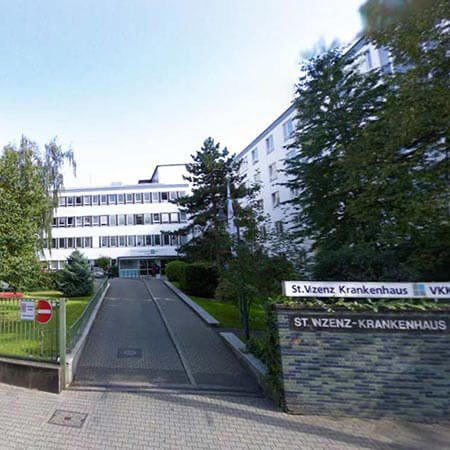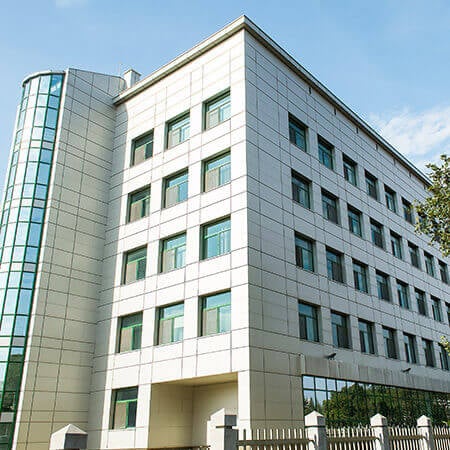Ankle Arthritis — Total Ankle Replacement: treatment in the Best Hospitals in the World
Treatment prices are regulated by national law of the corresponding countries, but can also include additional hospital coefficients. In order to receive the individual cost calculation, please send us the request and medical records.

Department of Adult and Pediatric Orthopedics, Foot Surgery
The Department of Adult and Pediatric Orthopedics, Foot Surgery offers the widest range of modern medical services to patients suffering from musculoskeletal diseases. The department specializes in knee and hip replacement surgery, including revision interventions to replace previously implanted artificial joints. The department has the status of a certified Maximum Care Endoprosthetics Center (endoCert), which means adherence to the requirements of European professional societies for carrying out procedures of this kind, a high level of safety and treatment efficiency. It is worth noting that the department uses the innovative ROSA® robotic system for performing knee replacement surgery. A special Rapid Recovery Program is used for the rapid recovery of mobility after joint surgery, which allows the patients to quickly return to their usual life. An integral part of the department's clinical practice is also the treatment of foot diseases and deformities in adults and children. The medical facility has been operating for more than 50 years, and therefore it provides patients with the highest quality medical care and easily copes even with highly severe pathologies.




Department of Adult and Pediatric Orthopedics, Trauma Surgery, Foot Surgery, Hand Surgery and Rheumatology
The Department of Adult and Pediatric Orthopedics, Trauma Surgery, Foot Surgery, Hand Surgery and Rheumatology offers the full range of diagnostic and therapeutic services in its areas of specialization. The key areas of work of the department's doctors include large joint arthroplasty, arthroscopic interventions on the knee, hip, and shoulder joints, conservative and surgical treatment of foot and hand diseases and deformities, rheumatic joint lesions, orthopedic diseases in children, and musculoskeletal injuries. The key to successful clinical practice is the professionalism and unique experience of the department's medical team, combined with the advanced infrastructure and state-of-the-art equipment. The department has 5 operating rooms equipped with the latest technology. Most surgical interventions are performed using minimally invasive techniques, due to which, in the shortest possible time, the patient is verticalized, their mobility is restored, and a pronounced pain syndrome is excluded. The department annually performs more than 4,500 surgical interventions, including especially complex ones, so the specialists at the medical facility are rightfully proud of their impressive clinical experience in the surgical treatment of orthopedic diseases. Over the years, the department has gained an excellent reputation not only in Germany but also far beyond its borders.





Department of Adult and Pediatric Orthopedics
The University Hospital Ulm is an advanced medical complex that provides patients with high-class medical care using the very latest scientific achievements. The medical facility has been performing successful clinical activities for more than 40 years and has long earned an excellent reputation throughout Europe. The hospital regularly demonstrates high treatment success rates, takes an active part in the training of medical students, and works tirelessly on promising research projects. The university hospital consists of 29 specialized departments and 16 scientific institutes, where more than 7,000 highly qualified employees work for the benefit of their patients. More than 55,000 inpatients and about 300,000 outpatients are treated here every year. The hospital has 1,274 beds. The medical team of the hospital is focused on providing personalized medical services using the most modern and sparing diagnostic and treatment methods.






Ankle osteoarthritis leads to chronic pain and impaired limb mobility. There are two main surgical methods for its treatment: arthrodesis and replacement surgery. In countries with advanced medicine, the choice is increasingly made in favor of total ankle replacement. Although this operation is more complex, it provides better functional results and does not damage the other joints of the lower limb.
Not every hospital has experience with such operations, but in countries with advanced medicine, hundreds, and even thousands of such interventions are performed every year. The Booking Health company will find the most suitable hospital for you with experience in ankle replacement surgery. We will help reduce the cost of treatment and fully organize your trip.
Content
- Who may need ankle replacement?
- Ankle replacement difficulties
- How is total ankle replacement performed?
- Types of endoprostheses
- Why is it worth undergoing total ankle replacement abroad?
- Treatment in European hospitals with Booking Health
Who may need ankle replacement?
Deforming arthritis of the ankle is much less common than arthritis of the hip or knee. It occurs in about 1 out of 500 people. With the development of the advanced stage of the disease, the patient needs surgery. Arthritis usually develops secondarily after trauma.
Ankle replacement for arthritis is not considered the first-line treatment option. The most common operation is arthrodesis. During this intervention, the affected tissue is removed, and the bones are connected without the possibility of movement of the leg in the joint. Ankle replacement is mainly performed in elderly patients with low movement activity.
In recent years, ankle replacement surgery has become increasingly common. This is due to the fact that new types of endoprostheses have appeared and they are more resistant to load.
The standard replacement surgery has many disadvantages. After it, the load on the hip and knee joints, as well as on the metatarsal and tarsal joints of the foot, increases. Over time, this leads to their damage. Feet joints are the first to suffer: the patient may need arthrodesis surgery.
In addition, the functional outcome after ankle fusion is worse than after ankle replacement. Functional deficits are especially severe when walking and running.
Another significant disadvantage is the long immobilization period. After a total ankle replacement, rehabilitation begins almost immediately after the intervention, but after arthrodesis, a person must spend several weeks in a cast. External fixation devices are often used.
Total ankle replacement has no such disadvantages, that is why this treatment method is increasingly used in modern medicine. After replacement surgery, the movements in the joint are natural, so the adjacent joints of the lower limb are not damaged, but this surgical procedure is technically more complex. It is best performed in a country with a high level of medicine. The effectiveness and long-term results of total ankle replacement depend largely on the accuracy of placement and the quality of the endoprosthesis.
Total ankle replacement is substitution of diseased ankle joint with prosthesis.
Comprehensive rehabilitation program in the specialized hospital will give the best result.
These are Germany and Turkey.
Cost of ankle arthritis treatment with total replacement is from €6,181. You can find other prices on the Booking Health website.
The best hospitals in Europe are:
- University Hospital Rechts der Isar Munich
- University Hospital of Ludwig Maximilian University of Munich
- University Hospital Ulm
- University Hospital Frankfurt-am-Main
- Vitos Orthopedic Clinic Kassel
Ankle replacement difficulties
The ankle joint is formed by three bones: the talus, tibia and fibula. This is a complex anatomical formation, which can withstand heavy loads. In terms of the frequency of injury, the ankle joint ranks second after the shoulder joint. Although sports medicine has reached the highest level of development, doctors are not always able to fully restore the damaged joint, and therefore many patients subsequently suffer degenerative changes – post-traumatic arthritis.
At the end of the twentieth century, the first operations in replacement surgery became widespread: knee and hip replacement surgery. They gave good results. This led doctors to the idea that other joints, including the ankle one, could be easily replaced.
However, the first results showed that the ankle wears out much faster, and many patients develop complications at an early stage after the implantation of artificial joints: ankle fracture, endoprosthesis displacement due to "pushing" of an insufficiently dense cancellous bone.
The biomechanics of the ankle are very complex. In different types of loads, it can withstand from 3 to 13.5 times the human body weight. In addition, during the operation it is difficult to preserve the patient's own ligaments, which stabilize the ankle joint, while artificial stabilizers cannot fully replace them.
Dozens of years have passed, and new types of prostheses have been developed in Europe. They show good survival rates after 5-10 years. It is likely that the new types of endoprostheses will be able to serve for 20-30 years in many patients.
How is total ankle replacement performed?
The first successful total ankle replacement was performed by G. Lord and J.H. Marotte in 1970. They used a long-stemmed tibial component. It was connected to a polyethylene part, which rested on the talus. The operation was complemented by subtalar arthrodesis.
The endoprosthesis model turned out to be imperfect and did not receive further development. Twenty-five artificial joints were implanted, 12 of which loosened within 10 years. Moreover, only 7 patients received a good functional outcome. Subsequently, many other models were developed that gave even worse results, but after half a century, endoprostheses have become much better. The number of complications after their implantation is still higher than after replacement of other large joints of the lower limb. Nevertheless, many patients can expect that the endoprosthesis will serve for 10-20 years after the implantation.
Today, the doctors use about 15 models for ankle joint replacement. Surgery for ankle endoprosthesis implantation is not frequent. Germany is one of the few countries, which regularly performs these complex interventions for arthritis treatment. Orthopedists perform about 1,500 operations annually – the same number as in all other European countries.
High-quality endoprostheses of European production have already appeared. They have good functionality and resistance to load. They wear out slowly, and complications after their implantation are less common. An artificial polyethylene meniscus is inserted between the articular surfaces, which softens the load at the bone-metal interface. It reduces the risk of endoprosthesis loosening.
Artificial joints with lateral planes of the talus component are used – they protect the articular cartilage of the ankles. Endoprosthesis ensures the best results in patients with lateral ankle joint injury caused by arthritis.
Today, the results of arthritis treatment with replacement surgery have improved significantly. Only 3% of cases require a second surgery within 2 years. The likelihood of modern endoprosthesis loosening within 10 years is about 15%. It is increased in the following patients:
- Young and physically active patients.
- Patients with varus or valgus (outward or inward) deviations of more than 10 degrees.
- In patients with significantly deformed articular surfaces of the tibia and talus.
Surgery is usually performed under spinal anesthesia. The doctor makes an incision in the ankle, removes the patient's own tissue and replaces it with components of the endoprosthesis. Surgeons try to remove as few bone structures as possible in order to improve treatment results. This is because the bone becomes less dense further from the ankle. In case of significant bone resection, the risk of ankle protrusion and instability increases.
Both cement and cementless methods can be used to fix the endoprosthesis. Artificial joints of the very latest generation are fixed without cement. Today, they remain the standard for total ankle replacement surgery.
Types of endoprostheses
There are two main classes of endoprostheses for total ankle replacement:
- Constrained.
- Unconstrained.
The constrained endoprosthesis replaces the patient's own ligaments using stabilizing systems, but it cannot compensate for all the mechanical features of the ankle. Joint instability develops within a few years. This is due to the huge load on the fixation zones of the endoprosthesis. Due to the rapid wear, constrained endoprostheses are rarely used.
A large study showed that after the implantation of a constrained prosthesis, a recurrent operation was required in 40% of patients within 9 years of supervision. The causes are pain, infection, friction between the prosthesis and the ankles (impingement syndrome).
Unconstrained prostheses are used more often. There are functional models with several axes of rotation. The load on the bone at the fixation points is much less, so artificial joints do not wear out so quickly.
By the type of movement, artificial joints can be:
- Single-axis.
- Polyaxial.
The implantation of polyaxial endoprostheses offers maximum benefits for patients with a stiff hindfoot. The implantation of such an artificial joint can restore supination and pronation, which reduces the load and prevents mechanical loosening.
Why is it worth undergoing total ankle replacement abroad?
If hip and knee replacements are performed almost everywhere, total ankle replacements are rare. In most countries, the number of interventions performed per year is calculated not even in hundreds, but in tens. Doctors have minimal experience in performing them, so it is not always possible to count on good results.
However, total ankle replacement in some countries is already included in the standard medical care for patients with arthritis. Germany is the country with the most developed medicine. It performs about 1,500 such surgical procedures annually. Some orthopedic surgeons perform dozens of total ankle replacements each year. They have gained sufficient experience, and can correctly select and accurately implant an endoprosthesis.
Although the cost of treatment in Western Europe may be higher than in your native country, you can get much better and more reliable outcomes in hospitals abroad. Here are several reasons why it is worth undergoing ankle arthroplasty abroad:
- Accurate diagnosis allows the specialists to accurately select candidates for total ankle replacement who can expect good long-term results.
- The use of high-quality endoprostheses of the very latest generation. They restore normal ankle biomechanics and wear out more slowly.
- Vast experience in total ankle replacement. The developed European countries perform hundreds of operations annually, and Germany performs about 1,500 surgical interventions every year.
- Minimal risk of early complications, which require additional treatment in the first months after surgery.
- Low risk of endoprosthesis loosening due to its precise positioning.
Europe can offer advanced medicine. Doctors in this country perform surgical interventions of any complexity. At the same time, complications develop rarely and good functional results are achieved, which persist for many years.
Treatment in European hospitals with Booking Health
Please use the services of Booking Health, if you want to undergo treatment in European hospital. On our website, you can see the cost of treatment in different hospitals, compare prices and book a medical program at an affordable price.
Please contact the Booking Health specialists to undergo treatment in European hospital. We will provide the following benefits for you:
- We will choose the best European hospital, whose doctors specialize in the treatment of ankle arthritis.
- We will help you overcome the language barrier, establish communication with your attending physician.
- We will reduce the waiting time for the medical care program and book a doctor's appointment on the most suitable dates.
- We will reduce the price. The cost of treatment in European hospitals will decrease due to the lack of additional coefficients for foreign patients.
- We will take care of all organizational issues: documents for entering the country, transfer from the airport, hotel, interpreter, etc.
- We will elaborate a medical care program and translate medical documents. You do not have to repeat previously performed diagnostic procedures.
- We will ensure communication with the European hospital upon the completion of treatment.
- We will organize additional diagnostic tests and treatment in European hospitals, if necessary.
- We will buy medicines abroad and forward them to your native country.
- We will help you keep in touch with the hospital and the doctor upon the completion of treatment in European hospital.
Booking Health makes treatment in European hospitals easier, faster and cheaper. We will fully organize your trip, and you will only have to focus on restoring your health.
Authors:
This article was edited by medical experts, board-certified doctors Dr. Nadezhda Ivanisova, and Dr. Bohdan Mykhalniuk. For the treatment of the conditions referred to in the article, you must consult a doctor; the information in the article is not intended for self-medication!
Our editorial policy, which details our commitment to accuracy and transparency, is available here. Click this link to review our policies.

